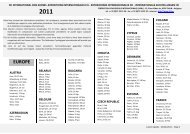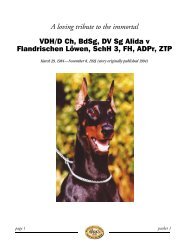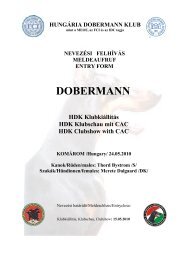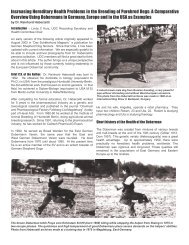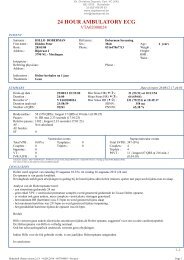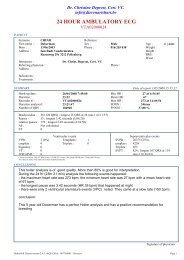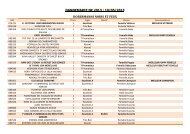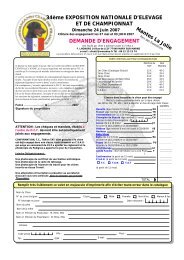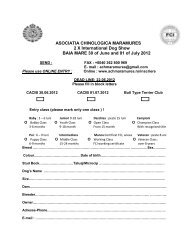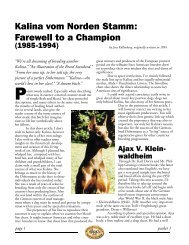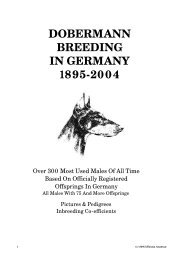Breeding Programme
Breeding Programme
Breeding Programme
Create successful ePaper yourself
Turn your PDF publications into a flip-book with our unique Google optimized e-Paper software.
The selection<br />
Selection is the basis of all breeding. It is however possible to select only if :<br />
-there is enough differences between the animals in the population for the trait in focus (= selection difference),<br />
-the difference is truly based on a genetical difference,<br />
-the trait can be distinguished from the animals phenotype,<br />
-there is as great accuracy in tests as possible and so a high heritability value.<br />
A selection difference means that the animals which are selected for breeding are better than the average population.<br />
The better the selection criteria, the faster the success in breeding. If we can’t influence the trait’s heritability<br />
value, we can try to influence selection differences.<br />
1. Accuracy of selection. Most traits are influenced by the environment. Not all observable animal differences are<br />
genetic. Traits which are highly influenced by the environment (low heritability value) are not possible to select<br />
and the estimation of the animal’s breeding value is random. Also the need for a strong selection based on the<br />
traits which are not harmful for the breed must be questioned, even if the reliability of the test result would be<br />
good (for example v.Willebrandt test). It may be necessary to lower the selection criteria in tests for problems of<br />
less importance or traits of less reliable results to lower the risk of spreading difficult diseases because of a small<br />
effective population size.<br />
2. In the selection, only the good or best animals should be used in breeding. With strict selection, we easily<br />
lower the number of animals left in breeding. The animals become too close relatives and the COI of the population<br />
increases. There is also a danger that the selection is based on success which has no genetic influence.<br />
3. The success in breeding is affected also by the number of the traits we are selecting for. If only a few traits are<br />
used in selection, the breeding is successful during some generations. The speed is further better if the traits have<br />
high a heritability value. Quite the opposite happens if there are many selection criteria and the traits in question<br />
have low heritability values. In the worst case, the progress is random.<br />
4. It may be wise to favor shorter generation intervals and breed the animals earlier. This way it is possible to<br />
get useful information of the animal’s breeding value through its offspring using progeny tests. The test which<br />
analyze behaviour would be more reliable if they could be done at the earlier age than today. The environmental<br />
affects on the test results is smaller and the results can be taken into use earlier. Early results make it possible to<br />
stop the use of a sire temporarily and to continue later after analyzing the progeny results.<br />
The selection can be done using three different methods:<br />
Tandem<br />
Independent selection<br />
Index selection<br />
In tandem breeding, selected animals are ranked, for example, according to one trait in a year and this is continued<br />
until the trait in question is stabilized enough into the population. Next year or another time a new trait is<br />
taken into the selection. This method is not practical to use.<br />
An independent selection is a selection based on the limit values which the animals must reach in each trait. The<br />
animal is rejected from breeding if one of the limits is not reached, even if other values are passed.<br />
In index breeding, the animals proposed for breeding are ranked according to their total breeding value. The total<br />
breeding value is the sum of the individual traits values.<br />
When comparing these three selection methods, we can say that the index breeding is as good as or better than<br />
independent selection which in turn is as good as or better than tandem breeding.<br />
It is important that breeders understand the pros of independent selection compared to its cons. The disadvantage<br />
of independent breeding is that a breed too easily can loose top quality individuals for one trait because<br />
the limit is not met in the other trait. This method favors individuals having medium quality genes.<br />
In the index breeding, every trait which we want to use in selection should have a weighted value according<br />
to the importance and reliability of the test result of a trait. The benefit of the index breeding is, that we can try to<br />
save the top genes in the population. It is also possible by giving a new weight to one trait to change the direction<br />
of the breeding quickly. This method enables us to selectively breed several traits.<br />
Index breeding is the modern breeding method. In the true index breeding, we must use computers, special<br />
programs and specialized persons to count the indexes. It is though good to understand the benefits of this<br />
method compared to independent breeding method.<br />
The Finnish Dobermann Club’s BREEDING PROGRAMME 17




